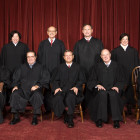
Life Sentences, Long Sentences Imposed on Youth Need 2nd Look
|
Decades of research from the fields of criminology and adolescent brain science find that the decisions made in youth — even very unwise decisions — do not...
Juvenile Justice Information Exchange (https://jjie.org/tag/graham-v-florida/)

Decades of research from the fields of criminology and adolescent brain science find that the decisions made in youth — even very unwise decisions — do not...

2005 – Roper v. Simmons: U.S. Supreme court rules that it is cruel and unusual punishment to impose the death penalty on people for crimes committed when they were younger than 18. “[F]rom a moral standpoint it would be misguided to equate the failings of a minor with those of an adult, for a greater possibility exists that a minor’s character deficiencies will be reformed.” Roper v. Simmons, 543 U. S. 551, 570 (2005).
2010 – Graham v. Florida: U.S. Supreme Court rules that life-without-parole sentences imposed on children for non-homicide offenses are unconstitutional. “‘(J)uvenile offenders cannot with reliability be classified among the worst offenders.’ “ Graham v, Florida, 130 S. Ct. 2011, 2026 (2010), quoting Roper, 543 U.S., at 573.“Juveniles are more capable of change than are adults, and their actions are less likely to be evidence of ‘irretrievably depraved character’ than are the actions of adults. Id.
2011 -- J.D.B. v. North Carolina: U.S. Supreme Court establishes that youth status matters in areas of youth justice beyond the context of harsh sentencing policies when it imposed the requirement that law enforcement officials must consider the age of a suspect in determining whether Miranda warnings should be issued.

California has always been ahead of the curve. Fresh on the heels of the Supreme Court ruling in Miller v. Alabama, which prohibits mandatory juvenile life without parole sentences (JLWOP), the California Supreme Court announced that a 110-year sentence for a non-homicide crime was the equivalent of juvenile life without parole and thus unconstitutional in the case of People v. Caballero. Caballero, who was 16 at the time his crimes occurred, would have had to serve 110 years in prison before even having the possibility of going before a parole board. The California Court’s opinion, released August 16th 2012, relies heavily on the reasoning put forth by the United States Supreme Court two years earlier in Graham v. Florida, where it flatly prohibited a JLWOP sentence for a non-homicide crime. The Caballero Court noted that developments in psychology show fundamental differences between juvenile and adult minds, that a life without parole sentence serves a very limited penological purpose for juveniles, and that children have the greatest possibility of rehabilitation.

One hundred years ago yesterday, Virginia’s governor was “besieged” with pleas for clemency for 17-year-old Virginia Christian, scheduled to die that day in the state’s electric chair for murder. A century later, the California Supreme Court scheduled an opinion on a latter-day juvenile defendant facing what some say is a similar sentence. The century makes a difference in treatment of underage criminals. Christian, a black young woman, was headed to the electric chair in 1912 for “the murder of Mrs. Ida Virginia Belote, a frail white woman aged 72 years,” after a dispute over laundry the girl had not returned. According to a century-old story in the New York Times, the murder weapons were a poker, a cuspidor and a towel.

Despite the recent Supreme Court ruling in Miller v. Alabama, the United States will remain the only country in the world to sentence children to spend their lives in prison. Like countries worldwide, our laws prohibiting children from marrying, voting and drinking recognize that those under the age of 18 are categorically different from adults -- a difference we fail to apply to their treatment under criminal law. Enshrined in laws in 28 states and in federal court, children in the United States could be transferred to adult court, tried as adults, and subject to mandatory sentencing schemes. In the Miller decision the Court ruled that a mandatory sentence of life without parole is unconstitutional when applied to juveniles for homicide crimes. Under this decision, judges in all U.S. courts are required to take into account factors such as the defendant’s age, background, involvement in the crime, and possibility of rehabilitation before issuing a sentence.

As Supreme Court arguments from two key juvenile sentencing decisions trickle down through courts and legislatures nationwide, the heaviest sentences for juveniles may be on the verge of shedding some weight. “Graham and Miller put a constitutional ceiling on what states can do to kids,” argues Los Angeles attorney David Durchfort, continuing, “the big question now is what’s the safe zone? How far can they [states] go in punishing kids without giving them a second chance?”
Graham and Miller, decided by the U.S. Supreme Court in 2010 and 2012 respectively, bar state laws that mandate life without parole sentences for juveniles. In both cases, the court said children are immature from a brain chemistry point of view. Therefore they are more corrigible and less culpable than adults and cannot rightfully be sentenced to life without parole until a judge takes that youthfulness into consideration.

WASHINGTON, D.C. -- “Why is life without parole categorically different? How about 50, 60, 70 years? As close to death as possible? How are we to know where to draw those lines?” Justice Antonin Scalia was first out of the box to fire questions at defendant’s attorney Bryan Stevenson. However, on the first day of Spring in the city of cherry blossoms, all eyes and ears within the U.S. Supreme Court were focused on Justice Anthony Kennedy. Would he repeat the message of hope for young people when he so eloquently wrote for the majority two years earlier in Graham v. Florida: “Life in prison without the possibility of parole gives no chance for fulfillment outside prison walls, no chance for reconciliation with society, no hope.” (Before Graham, the Court’s decision in Roper v. Simmons had ruled the death penalty for juveniles unconstitutional.)
Relying upon scientific evidence that kids are different from adults because their brains hadn’t fully developed and thus lacked impulse control and judgment, the Graham decision held life without parole sentences for juveniles convicted of crimes other than homicides to be cruel and unusual punishment, thus unconstitutional.

Seven years ago, in Roper v. Simmons, the U.S. Supreme Court recognized fundamental differences between children and adults that bear directly on the issue of culpability to outlaw imposition of the death penalty for any crime committed by a defendant younger than 18. Five years later, in Graham v. Florida, it relied on the same principles to ban life sentences without parole for juveniles convicted of non-homicide offenses. Next week, the Supreme Court will consider whether those principles must once again render a life-without-parole sentence unconstitutional for youth convicted of homicide offenses when it hears the cases of Kuntrell Jackson and Evan Miller, who were both sentenced to die in prison for crimes they committed when they were 14. Because there is no scientific, legal or practical reason to disregard the findings in Roper and Graham, the established constitutional law must prevail and life-without-parole sentences for all teenagers, including Jackson and Miller, must be prohibited as excessive. Life imprisonment without parole, which discounts any possibility for rehabilitation, is a severe sentence for any offender. For a teenager, it is an extraordinary punishment in both length and psychological severity.

As the U.S. Supreme Court prepares to hear oral arguments in the cases of two 14-year-olds sentenced to spend the rest of their lives in prison, many advocates and attorneys predict a majority of the justices will decide that life sentences for juveniles without the possibility of parole amounts to cruel and unusual punishment. Children are “categorically different” from adults, says Andrea Dennis, associate professor at the University of Georgia School of Law, and she wants to see the Court acknowledge that. “At a minimum,” she said, “I hope the court would reject mandatory juvenile LWOP [life without parole] sentences for all homicide crimes and require juries be allowed to consider the defendant’s youth and other factors as mitigation.”
In both cases, Jackson v. Hobbs and Miller v. Alabama, the sentences were mandatory regardless of the defendant’s age or circumstances and the judges had no discretion in sentencing. In Jackson, a 14-year-old was convicted as an accomplice to the murder of a store clerk. He did not have a gun or pull the trigger.
There are new legal challenges popping up across the country in the wake of the Graham v. Florida Supreme Court decision, which made life without parole sentences for juveniles unconstitutional in cases that don’t involve murder. Unlike appeals filed in Florida and Pennsylvania, the American Civil Liberties Union is suing Michigan government officials on behalf of nine convicts who were sentenced to life in prison without possibility of parole for crimes they committed when they were minors, according to the Jurist. Michigan law requires mandatory life sentences for certain crimes committed by kids who are 14 to 17 years old. The ACLU argues their rights have been violated because they don’t have the chance for parole by demonstrating growth or maturity.